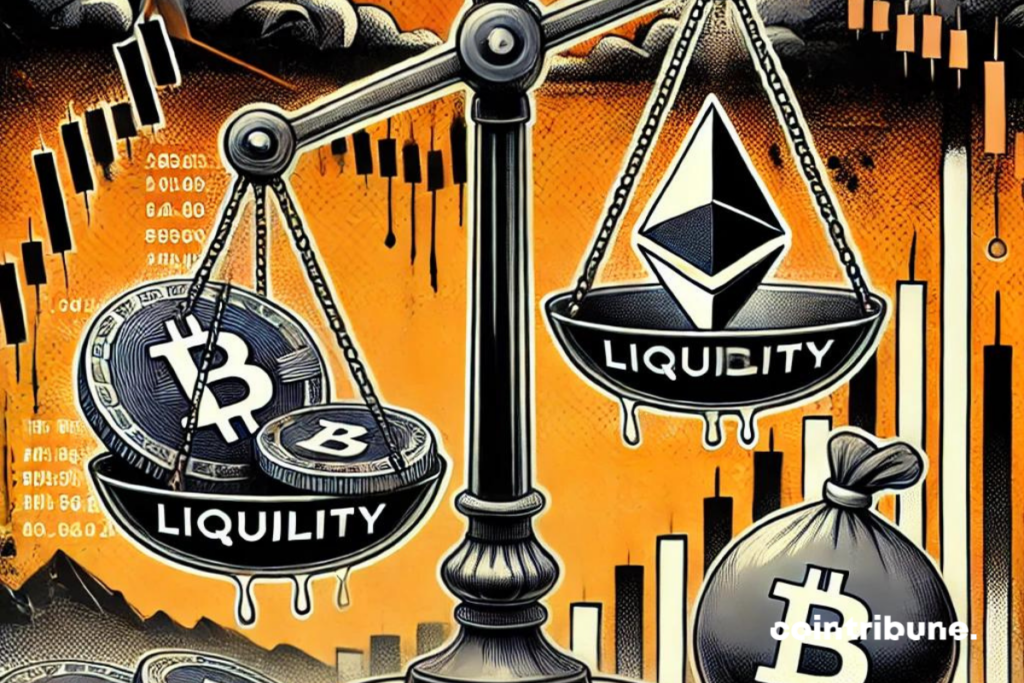Did You Think That Bitcoin And Ethereum ETFs Would Change Everything For Cryptocurrencies? Wrong…
The question of liquidity in the crypto market remains a major challenge. The recent introduction of exchange-traded funds (ETFs) on Bitcoin (BTC) and Ethereum (ETH) in the United States had raised hopes for improvement. However, according to the latest report from Kaiko, these expectations have only been partially met. Despite an increase in trading volumes on major platforms since November 2022, the reality is that the market remains fragile and vulnerable to sudden fluctuations. This report highlights two areas of reflection: the limited impact of ETFs on the true market liquidity, and structural issues.

The limited impact of ETFs on crypto market liquidity
Published on August 29, 2024, Kaiko’s report states that the introduction of ETFs on Bitcoin and Ethereum raised hopes for an improvement in liquidity in the crypto markets. Since the collapse of FTX in November 2022, there has been a 30% increase in daily trading volume on the top ten crypto exchange platforms. However, this increase does not necessarily translate into sufficient liquidity to absorb large orders. Indeed, the report emphasizes that trading volume, while an indicator, is not an absolute measure of liquidity. It can be inflated by activities such as wash trading or incentives offered by trading platforms.
Kaiko insists on the importance of “market depth,” which measures the ability of a market to absorb large orders without causing significant price movement. The volume/market depth ratio is proposed as a more reliable indicator to assess true liquidity. To date, even with increased trading volume, the crypto market is not yet ready to face major impacts, as evidenced by the recent market drop on August 2 following an unexpected rate hike by the Bank of Japan. This event caused significant “slippage” on Bitcoin orders, with trading pairs like BTC-EUR on KuCoin seeing slippage exceed 5%.
The market still under pressure from “supply overhangs”
Beyond the limited effects of ETFs, Kaiko’s report highlights other challenges. A key factor is the “supply overhang,” which refers to the presence of large stocks of cryptos that could be liquidated on the market. For example, the legacy of Mt. Gox, with its 46,000 BTC still to be redistributed, is a constant sword of Damocles. Each successive distribution causes a new wave of selling, creating additional market disruptions. Furthermore, many governments, including those of the United States, China, and Ukraine, hold large amounts of Bitcoin that they could choose to sell at any time, which would amplify the risks of volatility.
These potential sales, combined with already limited liquidity, exacerbate the risks of high “slippage” and unexpected price fluctuations. Kaiko’s report notes that these market dynamics complicate risk forecasting and management for investors, even the most experienced ones. Additionally, the variation in liquidity levels throughout the day, with particularly pronounced periods of low liquidity, reflects a lack of robustness in the current market structure.
Although the introduction of ETFs on Bitcoin and Ethereum has offered some improvement in liquidity, issues (especially liquidity tightening) persist for the crypto market. Between risks related to “supply overhangs” and the fragility of market depth, the sector remains vulnerable to shocks.
Maximize your Cointribune experience with our "Read to Earn" program! For every article you read, earn points and access exclusive rewards. Sign up now and start earning benefits.
Diplômé de Sciences Po Toulouse et titulaire d'une certification consultant blockchain délivrée par Alyra, j'ai rejoint l'aventure Cointribune en 2019. Convaincu du potentiel de la blockchain pour transformer de nombreux secteurs de l'économie, j'ai pris l'engagement de sensibiliser et d'informer le grand public sur cet écosystème en constante évolution. Mon objectif est de permettre à chacun de mieux comprendre la blockchain et de saisir les opportunités qu'elle offre. Je m'efforce chaque jour de fournir une analyse objective de l'actualité, de décrypter les tendances du marché, de relayer les dernières innovations technologiques et de mettre en perspective les enjeux économiques et sociétaux de cette révolution en marche.
The views, thoughts, and opinions expressed in this article belong solely to the author, and should not be taken as investment advice. Do your own research before taking any investment decisions.